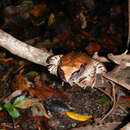Description
provided by AmphibiaWeb articles
Diagnosis: Can be distinguished from other members of the Mixophyes schevilli species complex by the following combination of characters: posterior surface of thighs uniformly dark with many small pale rounded spots (9-35 spots per thigh, 1.0-1.7 mm in diameter), evenly distributed along the length of the thigh for M. carbinensis, vs. 1-13 symmetrical pale blotches with dark borders, 1-6 mm in diameter, concentrated on the distal thigh for M. schevilli, or 0-9 large irregular pale blotches with dark borders, 1-11 mm in diameter, concentrated on the distal thigh for M. coggeri. In M. carbinensis the patterning on the dorsal and posterior surfaces of the leg is more visible as it contrasts more strongly with the ground color than in M. schevilli and M. coggeri (Mahony et al. 2006).Description: Adult males measure 59-72 mm SVL. Adult females measure 67-78 mm SVL. Flat head with large eyes and a prominent rounded snout. Below the well-defined straight canthus rostralis is a concave loreal region which becomes convex towards the upper lip. Eyes are large. Pupils are vertical when constricted. Tympanum is large and oval-shaped, with a diameter 0.85x of eye length. Vomerine dentigerous processes form long straight rows, from the anterior margin of the choanae to the midline between the choanae. Tongue is rectangular and has a posterior notch. Fingers are long and slender and lack webbing. Prominent subarticular and palmar tubercles. Relative finger lengths III>IV>I=II. Hind limbs are moderately long (TL/SVL = 0.61). Fully webbed toes except for distal phalanx on Toe IV, which is fringed. Relative toe lengths IV>V>III>II>I. Toes lack subarticular tubercles. Inner metatarsal tubercle has distinct outer edge; outer metatarsal tubercle is absent. Smooth venter and dorsum. Males have a brown glandular nuptial pad on the inner palmar tubercle and along the entire length of Finger I except for the finger disc (Mahony et al. 2006). In life, the dorsal surfaces of the body and limbs range in coloration from light beige to copper brown. Mid-dorsal stripe, patches, limb barring and the suborbital area are dark chocolate brown, often with a thin cream-colored border. The lateral stripe on the head is black with a thin cream-colored or fawn-colored border that stands out against the black stripe but shades into ground color. Tympanum dark brown, without a light border. Upper lip has small black blotches below eye. Lateral triangular patch (dark brown or black with a light brown center) extends from the naris to the jaw. Iris dark brown. Venter is creamy. Posterior thigh is dark gray to black with small round creamy spots. Triangular dark brown to black patches on the side of the limbs. Ventral surfaces of limbs are gray. Dorsal surfaces of fingers and toes same shade of brown as dorsum. The webbing between the toes is black. Nuptial pads in males are gray to brown (Mahony et al. 2006).In preservative, dorsum is a dark chocolate brown. The mid-dorsal stripe is dark brown and has uneven edges which are black. On the dorsum are small dark brown patches with black edges. Dark lateral stripe on head. Dark triangular patches on the lateral edges of limbs. Forelimbs and hindlimbs have dorsal surfaces which are dark brown with distinct darker brown transverse bars that are narrower. Thighs are uniformly dark except for many rounded small pale specks (Mahony et al. 2006).The specific epithet refers to the Carbine Tableland, which is within the species' range (Mahony et al. 2006).
McDonald, K. and Richards, S. (2008). Mixophyes carbinensis. In: IUCN 2010. IUCN Red List of Threatened Species. Version 2010.1. www.iucnredlist.org. Downloaded on 21 May 2010.
Distribution and Habitat
provided by AmphibiaWeb articles
Endemic to northeastern Queensland, Australia. Found only in the Carbine Tableland (on Mt. Lewis and Mt. Spurgeon) and Windsor Tableland (Mahony et al. 2006), from 700-1,300 m asl (McDonald and Richards 2008). Habitat is montane rainforest; this species is found associated with clear, flowing streams and nearby pools (McDonald and Richards 2008).
Life History, Abundance, Activity, and Special Behaviors
provided by AmphibiaWeb articles
Breeds in spring and summer. Males call from leaf-litter on the rainforest floor, near clear, flowing streams and near ponds (McDonald and Richards 2008).
Life History, Abundance, Activity, and Special Behaviors
provided by AmphibiaWeb articles
The population trend appears to be stable. This species is common within its range, which is small. There are currently no major threats to this species, as much of its range is within national parks in the Wet Tropics World Heritage Area. No significant disturbance from tourism or recreational activities is present in the area; one minor road crosses the range (McDonald and Richards 2008).
Carbine barred frog: Brief Summary
provided by wikipedia EN
The Carbine barred frog (Mixophyes carbinensis), or Carbine frog, is a species of large frog that is endemic to Australia.
- license
- cc-by-sa-3.0
- copyright
- Wikipedia authors and editors

